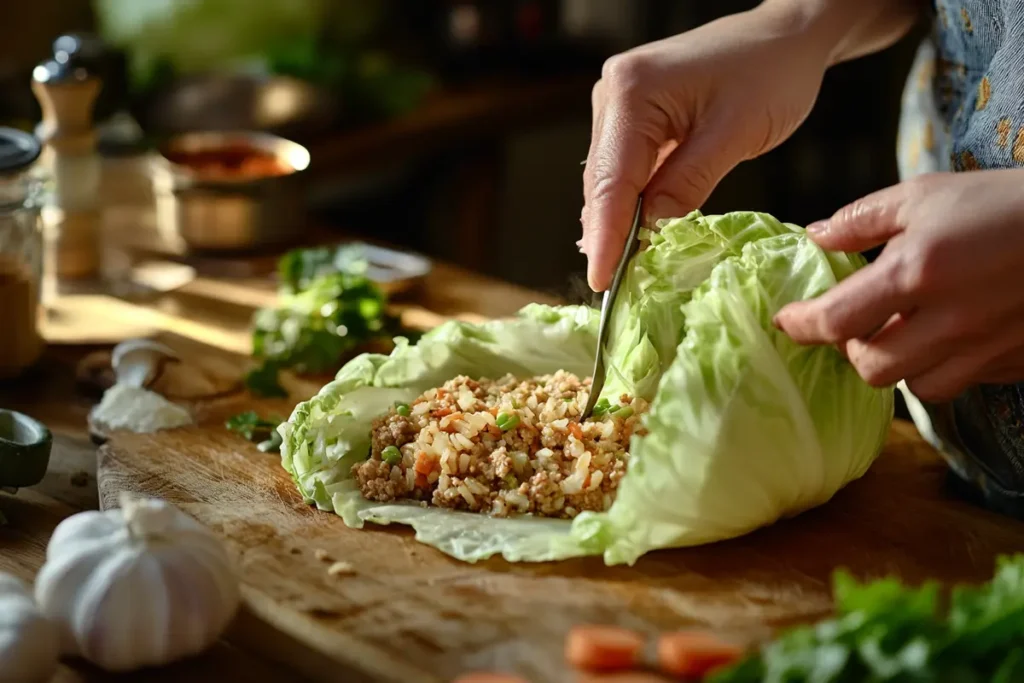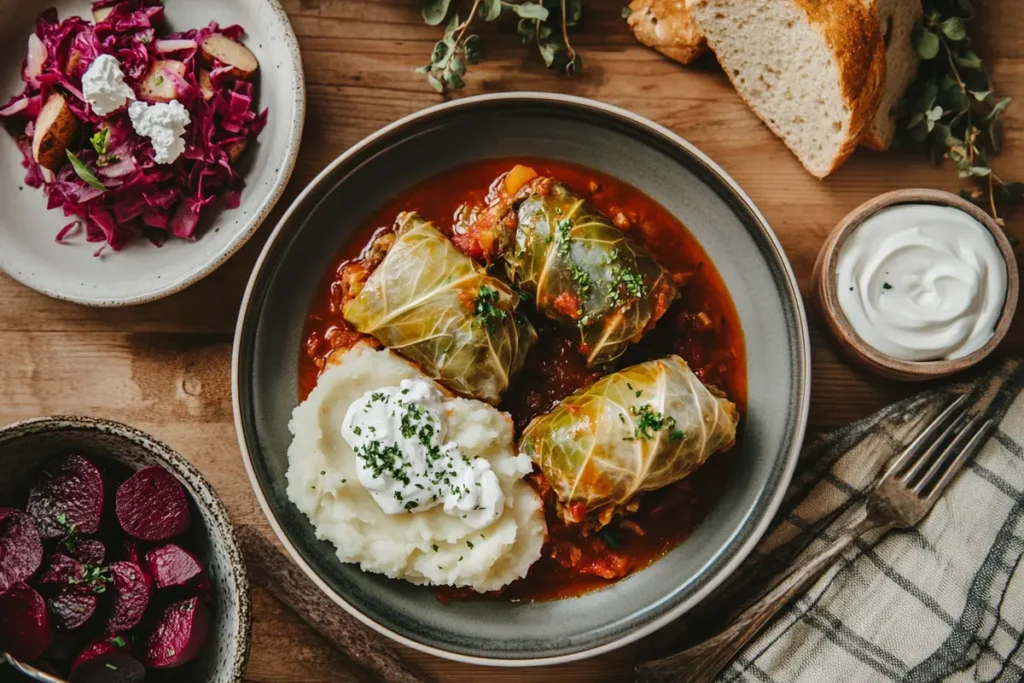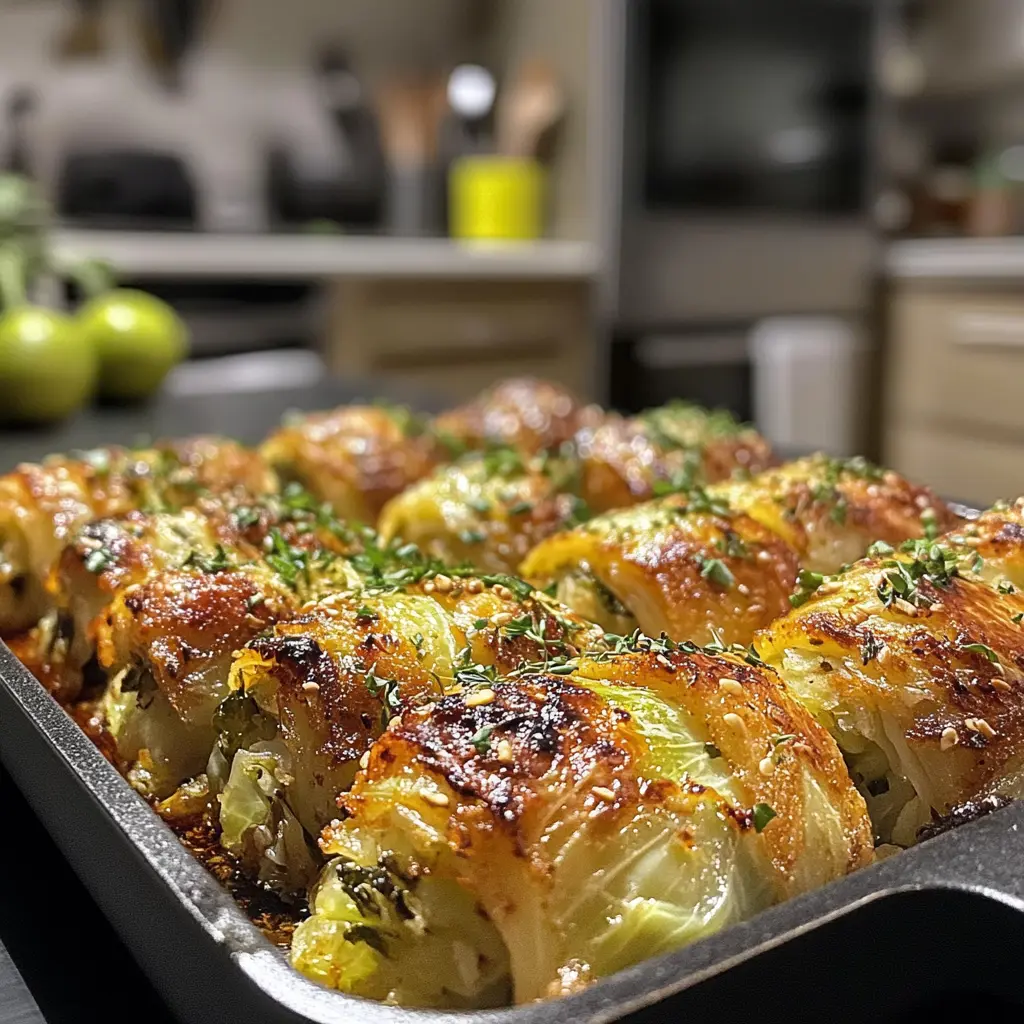Polish stuffed cabbage rolls, also known as Gołąbki, are a beloved traditional dish in Polish cuisine. These comforting rolls, filled with a delightful mixture of meat, rice, and spices, are wrapped in tender cabbage leaves and simmered in a rich tomato sauce. Whether you’re new to Polish cooking or looking to perfect your technique, this guide will walk you through everything you need to know about preparing, serving, and enjoying this classic meal.
The History of Polish Stuffed Cabbage Rolls
Polish stuffed cabbage rolls have a rich and varied history. They are thought to have originated in the Eastern European region, and their popularity spread quickly across neighboring countries. In Poland, these rolls are affectionately known as “Gołąbki,” meaning “little pigeons.” The dish’s name might stem from the small, rolled shape that somewhat resembles a bird.
The origin of cabbage rolls is hotly debated among many cultures in Eastern Europe, each claiming the dish as their own. The earliest mentions of stuffed cabbage can be found in the Middle Ages, when cabbage became a widely cultivated vegetable across Europe. The Polish version of cabbage rolls likely emerged during the 14th or 15th century, as people experimented with different ways to use this versatile and plentiful vegetable. Since then, Gołąbki has become one of Poland’s most popular comfort foods.
Today, Polish stuffed cabbage rolls are a staple at family gatherings, especially during holidays like Christmas and Easter. They have become a cherished comfort food, enjoyed by people from all walks of life. If you want to learn more about the fascinating history of Eastern European stuffed dishes, check out this detailed cultural overview or this traditional Eastern European cuisine page.
What Makes Polish Stuffed Cabbage Rolls Unique?
Unlike their cousins found in other Eastern European cuisines, Polish stuffed cabbage rolls are unique for their use of specific seasoning combinations and a focus on simplicity. While other countries have their versions, such as Ukrainian holubtsi, Hungarian töltött káposzta, or even Russian golubtsy, Polish rolls often focus on the perfect balance of pork, rice, and onions. Check out this guide on Eastern European stuffed cabbage variations to compare how different regions prepare this dish.
In Poland, Gołąbki are traditionally served with mashed potatoes, rye bread, or even as a standalone dish. The mild flavor of the cabbage blends wonderfully with the richness of the tomato sauce, making it a delightful, hearty meal. The emphasis is on showcasing the natural flavor of the pork filling, allowing each ingredient to shine without overpowering the others.
The use of cabbage itself is also significant in Polish culture. Cabbage is a symbol of resourcefulness, as it is widely available and can be preserved over long periods through fermentation, such as in sauerkraut. This versatility has made it a central component of Polish cooking, often serving as both an ingredient and a wrapping for dishes like Gołąbki. Polish recipes aim for balance—comfort, affordability, and nourishment.
Ingredients You’ll Need
To make authentic Polish stuffed cabbage rolls, gather the following ingredients:
| For the Rolls | Quantity |
|---|---|
| Large head of cabbage | 1 |
| Ground pork (or beef, or a mixture of both) | 1 pound |
| Uncooked white rice | 1/2 cup |
| Medium onion, finely chopped | 1 |
| Large egg | 1 |
| Breadcrumbs (optional) | 1/4 cup |
| Salt | 1 teaspoon |
| Black pepper | 1/2 teaspoon |
| Paprika | 1 teaspoon |
| For the Sauce | Quantity |
| Crushed tomatoes (15 ounces) | 1 can |
| Tomato paste | 1 tablespoon |
| Vegetable or chicken broth | 1/2 cup |
| Sugar (optional, to balance acidity) | 1 tablespoon |
| Dried thyme | 1 teaspoon |
| Bay leaf | 1 |
| Optional Garnishes | |
| Fresh chopped parsley | |
| Sour cream |
Step-by-Step Guide to Making Polish Stuffed Cabbage Rolls
Step 1: Prepare the Cabbage Leaves
To soften the cabbage leaves for rolling:
- Bring a large pot of salted water to a boil.
- Remove the core of the cabbage with a knife.
- Place the entire head of cabbage into the boiling water. Cook for 3-5 minutes until the leaves start to soften and loosen.
- Carefully peel off the softened outer leaves and set them aside. Continue cooking the cabbage until you have at least 12 large leaves.
Tip: If the leaves are still too stiff, place them back in the boiling water for an additional minute or two.
Alternative Method: Another method for preparing cabbage leaves is to freeze the entire head of cabbage overnight. Freezing and then thawing will naturally soften the cabbage leaves without the need for boiling.

Step 2: Prepare the Filling
While the cabbage cools, prepare the filling:
- In a medium pot, cook the rice according to package instructions. Set aside to cool slightly.
- In a large bowl, combine the ground pork, cooked rice, chopped onion, egg, salt, pepper, and paprika. Mix well until all ingredients are evenly incorporated.
Note: For extra tenderness, some cooks like to add breadcrumbs to the filling. This helps absorb any excess moisture and ensures that the filling remains light and fluffy.
Adding sautéed mushrooms to the filling can add an earthy flavor that complements the meat perfectly. For a more delicate taste, consider using a combination of beef and pork, or even a mixture of pork and ground chicken.
Step 3: Assemble the Rolls
- Lay a cabbage leaf flat on a clean surface. Add approximately 1/4 cup of the filling to the center of the leaf.
- Fold the sides of the leaf over the filling, then roll up from the bottom like a burrito. Place seam-side down.
- Repeat with the remaining cabbage leaves and filling.
Pro Tip: Avoid overstuffing the cabbage leaves to prevent them from tearing. If the leaf is particularly large, you may want to trim the thick rib to make rolling easier.

Step 4: Cook the Rolls
- In a large skillet, heat a bit of oil over medium heat. Add the stuffed cabbage rolls, seam-side down, to sear them lightly. This step is optional but adds a nice texture.
- Place the seared rolls in a large baking dish or Dutch oven.
- In a separate bowl, mix together the crushed tomatoes, tomato paste, broth, sugar, thyme, and bay leaf. Pour the sauce over the cabbage rolls.
- Cover the dish tightly with aluminum foil or a lid. Bake in a preheated oven at 350°F (175°C) for 1.5 to 2 hours.
Alternative Cooking Methods:
- Slow Cooker: After searing the cabbage rolls, transfer them to a slow cooker. Pour the sauce over them and cook on low for 6-8 hours.
- Stovetop: Place the stuffed cabbage rolls in a deep pot, cover them with the sauce, and simmer gently for about 2 hours, making sure to occasionally check the liquid level.

Tips for Perfect Stuffed Cabbage Rolls
- Cabbage Softness: If the cabbage leaves are difficult to work with, consider freezing the cabbage head overnight. Once thawed, the leaves will naturally soften, making them easier to roll.
- Sauce Consistency: To thicken the sauce, remove the foil during the last 20-30 minutes of cooking. If you like a thinner sauce, you can add more broth.
- Meat Mixture: Although pork is traditional, you can use beef or even ground turkey for a lighter version. You could also add grated carrots or celery to the filling to add more nutrients and texture.
- Seasoning: Don’t be afraid to adjust the seasoning in the filling to suit your tastes. Adding garlic powder, marjoram, or even nutmeg can add more depth to the flavor profile.
- Layering: When placing the cabbage rolls in the baking dish, make sure they are packed snugly to prevent them from unrolling during cooking.
Variations of Polish Stuffed Cabbage Rolls
Polish stuffed cabbage rolls are versatile. There are several popular variations:
- Vegetarian Gołąbki: Replace the meat with a mixture of mushrooms and lentils for a vegetarian option that is just as hearty and delicious. Chickpeas or black beans can also be used as a meat substitute, and adding some grated cheese to the filling will create a richer flavor.
- Spicy Rolls: Add diced jalapeños or a teaspoon of red pepper flakes to the meat mixture for a spicier kick. This variation adds a modern twist to the traditional dish, making it more appealing to those who enjoy a bit of heat.
- Sauerkraut Addition: Some recipes call for adding chopped sauerkraut to the filling or the sauce. This adds a tangy flavor that balances the sweetness of the tomato sauce. Sauerkraut can also be layered at the bottom of the baking dish for added flavor.
- Buckwheat Gołąbki: Instead of rice, try using buckwheat groats. Buckwheat is a common grain in Polish cooking and adds a slightly nutty flavor, making it a great alternative for those wanting to try something different.
Regional Differences in Stuffed Cabbage Rolls
Across Poland, different regions have their variations of Gołąbki:
- In Silesia, stuffed cabbage rolls are often served with a thick, creamy mushroom sauce instead of tomato sauce.
- In Masovia, it is common to use barley or buckwheat in place of rice, giving the dish a distinctive texture and flavor.
- In Podlasie, they sometimes add smoked bacon to the filling for an extra smoky flavor.
Each region has its touch, but all versions share the comforting core that makes Polish stuffed cabbage rolls a beloved dish across the country.
Serving Suggestions
Polish stuffed cabbage rolls are often served with simple side dishes that complement the rich flavors of the rolls:
- Mashed Potatoes: Creamy mashed potatoes make an excellent side dish, soaking up the delicious tomato sauce.
- Rye Bread: A slice of warm rye bread can be perfect for sopping up the remaining sauce on your plate.
- Sour Cream: Add a dollop of sour cream on top of each roll for extra creaminess and a slightly tangy contrast.
- Beet Salad: A refreshing beet and apple salad pairs wonderfully with the rich flavors of the rolls, adding a touch of acidity and sweetness.
- Fermented Vegetables: Serve with a side of fermented vegetables like sauerkraut or pickles for a classic Polish pairing that enhances the flavor.

Nutritional Information
One serving (two rolls) of Polish stuffed cabbage rolls contains approximately:
- Calories: 320 kcal
- Protein: 20g
- Fat: 15g
- Carbohydrates: 28g
- Fiber: 4g
This nutritional breakdown can vary depending on the type of meat and additional ingredients used. Opting for lean ground turkey or substituting rice with quinoa can lower the calorie count while maintaining nutritional balance.
Frequently Asked Questions
What is the difference between Polish and Ukrainian cabbage rolls?
Polish stuffed cabbage rolls, known as Gołąbki, often use a combination of pork and rice, wrapped in cabbage and simmered in a mild tomato sauce. Ukrainian cabbage rolls, or holubtsi, may include additional ingredients like mushrooms and often feature a stronger tomato-based or even cream-based sauce. The seasoning and fillings can also vary, with Ukrainians sometimes incorporating buckwheat or millet.
Are cabbage rolls German or Polish?
Cabbage rolls are found across many Eastern European cultures, including German and Polish cuisine. In Germany, these rolls are known as Kohlrouladen and are typically made with ground beef and bacon, whereas Polish Gołąbki emphasize pork and rice. While both versions share similarities, the specific spices and sauces used make each unique to their cultural heritage.
What is the difference between Halupki and Golumpki?
Halupki and Gołąbki are actually very similar dishes, with the primary difference being regional names and slight variations in preparation. Halupki is the name often used by Slovak Americans, while Gołąbki is the Polish term. Both refer to stuffed cabbage rolls, typically filled with a mixture of ground meat and rice.
How do you pronounce the Polish word for stuffed cabbage?
The Polish word for stuffed cabbage, Gołąbki, is pronounced “gaw-WOHM-bkee.” The “ł” sounds similar to an English “w,” and the emphasis is placed on the second syllable.
Can I make Polish stuffed cabbage rolls ahead of time?
Yes, Polish stuffed cabbage rolls can be made ahead of time. Assemble the rolls, place them in the baking dish, and cover them tightly with foil. You can refrigerate them for up to 24 hours before baking. This makes it convenient for preparing the dish in advance for family gatherings or special occasions. You can also freeze them—either before or after cooking. To freeze before cooking, assemble the rolls, place them in a baking dish, and cover them tightly. They can be frozen for up to 3 months. To serve, thaw overnight in the refrigerator and bake as directed.
Conclusion
Polish stuffed cabbage rolls, or Gołąbki, are a true comfort food that carries with it the warmth and tradition of Polish cuisine. Whether you’re making them for the first time or continuing a family tradition, these hearty rolls are sure to be a hit. With a perfect balance of flavors and a tender texture, they embody everything that makes Eastern European food so comforting and beloved.
Now that you know how to make Polish stuffed cabbage rolls, why not give them a try? Your family and friends will surely thank you for serving up this classic dish, filled with love and tradition.
Remember: The true secret to a great Gołąbki is in the patience and love you put into each roll. Cooking this dish is a labor of love that rewards you with flavors that are rich in history and heart. Happy cooking!
.

